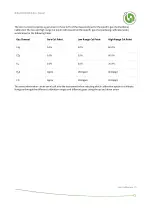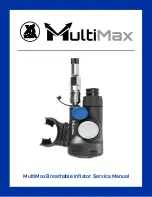
9ENG8008 GFM436 User Manual
Appendix B – Understanding Instruments For Use In Flammable Atmospheres
- 78
1.
2.
3.
17
Appendix B – Understanding Instruments For Use In
Flammable Atmospheres
17.1 Hazardous areas classified by zones
There are three zones defined to guide users as to the necessary precautions which should be taken when working
in potentially flammable atmospheres:
Zone 0 - An area in which an explosive gas/air mixture is continuously present, or present for long periods.
Zone 1 - An area in which an explosive gas/air mixture is likely to occur in normal operation.
Zone 2 - An area in which an explosive gas/air mixture is not likely to occur in normal operation and if it does
occur will exist only for a short time.
Make certain that the area in which you intend to work can be described by one of the zones above.
17.2 Different types of gas
Different gases are grouped according to how easily they are ignited. Some examples are given below. (For other
gases please contact the manufacturer).
Gas
Relative Ignition
Group
Hydrogen/Acetylene
Most easily ignited
IIC
Ethylene
IIB
Carbon monoxide
IIB
Hydrogen sulphide
IIB
Ammonia
IIA
Propane
IIA
Petrol vapour
IIA
NOTE:
This instrument is suitable for use in Zone 1 and 2.
Summary of Contents for GFM 436
Page 1: ...9ENG8008 GFM436 User Manual Exported on 02 02 2024...
Page 22: ...9ENG8008 GFM436 User Manual GFM436 Product Specification 22...
Page 24: ...9ENG8008 GFM436 User Manual GFM436 Product Specification 24 6 7 GFM436 Connections...
Page 30: ...9ENG8008 GFM436 User Manual GFM436 Operation 30...
Page 56: ...9ENG8008 GFM436 User Manual Storing Data 56...
Page 58: ...9ENG8008 GFM436 User Manual Storing Data 58...
Page 73: ...9ENG8008 GFM436 User Manual User Calibration 73...
Page 96: ...9ENG8008 GFM436 User Manual Appendix F ATEX UKEX and IECEx Certificate 96...
Page 97: ...9ENG8008 GFM436 User Manual Appendix F ATEX UKEX and IECEx Certificate 97...
















































